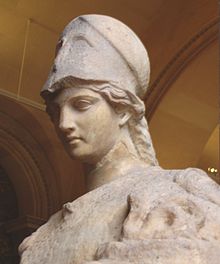|
Greek city of Mesembria in Thrace
Bronze 10mm (1.44 grams) Struck 350-200 B.C.
Reference: SNGBMC 278; SNG BMC Black Sea 278; Moushmov 3977
Helmeted head of Athena right.
META in the four quarters of a wheel.
An important colony of Megara, Mesembria was situated on the Black Sea coast,
north of Apollonia Pontika.
You are bidding on the exact item pictured,
provided with a Certificate of Authenticity and Lifetime Guarantee of
Authenticity.
Athena
or Athene
(Latin:
Minerva
), also referred to as
Pallas Athena, is the goddess of war, civilization, wisdom, strength,
strategy, crafts, justice and skill in
Greek mythology
.
Minerva
,
Athena’s Roman

incarnation,
embodies similar attributes. Athena is also a shrewd companion of
heroes and the
goddess
of
heroic endeavour. She is the
virgin
patron of
Athens
. The Athenians built the
Parthenon
on the Acropolis of her namesake
city, Athens, in her honour (Athena Parthenos). Athena’s cult as the patron of
Athens seems to have existed from the earliest times and was so persistent that
archaic myths about her were recast to adapt to cultural changes. In her role as
a protector of the city (polis),
many people throughout the Greek world worshiped Athena as Athena Polias
(“Athena of the city”).
Athens
and Athena bear etymologically connected
names.
Nesebar Mesimvria, previously known as Mesembria;
other spellings include Nessebar and Nesebur) is an ancient city
and a major seaside resort on the
Black Sea
coast of Bulgaria
, located in
Nesebar municipality
,
Burgas Province
. Often referred to as the “Pearl of the Black Sea”
and “Bulgaria’s
Dubrovnik
“,
Nesebar is a rich city-museum defined by more than three millennia of
ever-changing history.
It is a one of the most prominent tourist destinations and
seaports on the Black Sea, in what has become a popular area with several large
resorts—the largest,
Sunny
Beach
, is situated immediately to the north of Nesebar.
Nesebar has on several occasions found itself on the frontier
of a threatened empire, and as such it is a town with a rich history. The
ancient part of the town is situated on a peninsula (previously an island)
connected to the mainland by a narrow man-made
isthmus
, and
it bears evidence of occupation by a variety of different civilisations over the
course of its existence. Its abundance of historic buildings prompted
UNESCO
to
include Nesebar in its list of
World Heritage Sites
in 1983.
Originally a
Thracian
settlement known as Menebria, the town became a
Greek colony
when settled by
Dorians
from
Megara
at the
beginning of the 6th century BC, and was an important trading centre from then
on and a rival of Apollonia (Sozopol).
It remained the only
Doric colony
along the Black Sea coast, as the rest were typical
Ionic
colonies.
Remains from the
Hellenistic
period include the
acropolis
,
a temple of Apollo
,
and an agora
. A
wall which formed part of the fortifications can still be seen on the north side
of the peninsula. Bronze and silver coins were minted in the city since the 5th
century BC and gold coins since the 3rd century BC.
The town fell under
Roman
rule in 71 BC, yet continued to enjoy privileges such as the right to mint its
own coinage. It was one of the most important strongholds of the
Byzantine Empire
from the 5th century AD onwards, and was fought over by
Byzantines
and
Bulgarians
,
being captured and incorporated in the lands of the
First Bulgarian Empire
in 812 by
Khan Krum
after a two week siege only to be ceded back to Byzantium by Knyaz
Boris I
in 864 and reconquered by his son Tsar
Simeon the Great
. During the time of the
Second Bulgarian Empire
it was also contested by Bulgarian and Byzantine
forces and enjoyed particular prosperity under Bulgarian tsar
Ivan Alexander
(1331–1371) until it was conquered by
Crusaders
led by
Amadeus VI, Count of Savoy
in 1366. The Slavic[
neededcitation] version of the name, Nesebar or Mesebar, has
been attested since the 11th century.
Monuments from the
Middle
Ages
include the 5–6th century Stara Mitropoliya (“old bishopric”;
also
St Sophia
), a
basilica
without a transept
; the 10th century
church of the Virgin
; and the 11th century Nova Mitropoliya (“new
bishopric”; also
St Stephen
) which continued to be embellished until the 18th century. In the
13th and 14th century a remarkable series of churches were built:
St Theodore
,
St Paraskeva
,
St Michael St Gabriel
, and
St John Aliturgetos
.
The capture of the town by the
Turks
in 1453 marked the start of its decline, but its architectural
heritage remained and was enriched in the 19th century by the construction of
wooden houses in style typical for the
Bulgarian Black Sea Coast
during this period. It was a kaza centre in
Ä°slimye
sanjak
of
Edirne Province
before 1878[1].
After the
Liberation of Bulgaria
from Ottoman rule in 1878, Nesebar became part of the
autonomous Ottoman province of Eastern Rumelia as a kaza centre in
Burgaz
sanjak
until it
united
with the Principality of Bulgaria in 1886.
Around the end of the 19th century Nesebar was a small town
of Greek
fishermen and vinegrowers, but developed as a key Bulgarian seaside resort since
the beginning of the 20th century. After 1925 a new town part was built and the
historic Old Town was restored.
|










